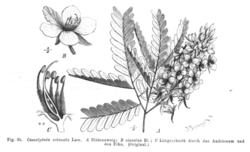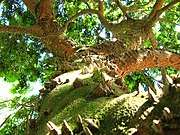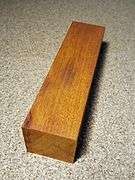Paubrasilia
Paubrasilia echinata is a species of flowering plant in the legume family, Fabaceae, and is endemic to the Atlantic Forest.[5] It is a Brazilian timber tree commonly known as Pernambuco wood or brazilwood (Portuguese: pau-de-pernambuco, pau-brasil; Tupi Ibirapitanga) and is the national tree of Brazil.[5] This plant has a dense, orange-red heartwood that takes a high shine, and it is the premier wood used for making bows for stringed instruments.[5][6] The wood also yields a red dye called brazilin, which oxidizes to brazilein.[7]
| Paubrasilia echinata | |
|---|---|
 | |
| An adult specimen in a square in Vitória, Brazil. | |
| Scientific classification | |
| Kingdom: | |
| (unranked): | |
| (unranked): | |
| (unranked): | |
| Order: | |
| Family: | |
| Subfamily: | |
| Tribe: | |
| Genus: | Paubrasilia (Gagnon, H.C.Lima & G.P.Lewis 2016) |
| Species: | P. echinata |
| Binomial name | |
| Paubrasilia echinata | |
| Synonyms[3] | |
| |
The name pau-brasil was applied to certain species of the genus Caesalpinia in the medieval period, and was given its original scientific binomial name Caesalpinia echinata in 1785 by Jean-Baptiste Lamarck.[3]. More recent taxonomic studies have suggested that it merits recognition as a separate genus, and it was thus suggested to be renamed Paubrasilia echinata in 2016.[3] The name of Brazil is believed by some to be shortened from Terra do Brasil "land of brazilwood".[8]
Name
When Portuguese explorers found these trees on the coast of South America, they recognised it as a relative of those Asian species of Caesalpinia that were already used in Europe for dye, or Portuguese pau-brasil, or as sappanwood.
The South American trees soon became the better source of red dye. Brazilwood trees were such a large part of the exports and economy of the land that the country which sprang up in that part of the world took its name from them and is now called Brazil.
Botanically, several tree species are involved, all in the family Fabaceae (the pulse family). The term "brazilwood" is most often used to refer to the species Paubrasilia echinata, but it is also applied to other species, such as Caesalpinia sappan and Haematoxylum brasiletto. The tree is also known by other names, as ibirapitanga, Tupi for "red wood"; or pau de pernambuco, named after the Brazilian state of Pernambuco.
In the bow-making business it is usual to refer to some species other than Paubrasilia echinata as "brazilwood"; examples include pink ipê (Handroanthus impetiginosus), Massaranduba (Manilkara bidentata) and palo brasil (Haematoxylum brasiletto). The highly prized Paubrasilia echinata is usually called "Pernambuco wood" in this particular context.
Description
The brazilwood tree may reach up to 15 metres (49 ft) in height, and the dark brown bark flakes in large patches, revealing the lustrous blood-red heartwood underneath. The leaves are pinnate and each consists of between 9 and 19 small, leathery leaflets, which are broadly oblong in shape.[9] The flower stalk, or inflorescence, is also branched and contains between 15 and 40 yellow, strongly perfumed flowers,[9] which may be pollinated by bees.[9] The petals are usually yellow with a blood-red blotch.[9] The fruits are oval-shaped woody seedpods, measuring up to 7.3 centimetres (2.9 in) long and 2.6 centimetres (1.0 in) across; they hang off the branches and after the seeds are expelled, the pods become twisted.[9] The branches, leaves and fruit are covered with small thorns.[9]
There are some important differences between geographically distinct populations and it is thought that separate subspecies of the pau brasil may exist.[9] This tree may have some medicinal properties and has been used as an astringent and antidiuretic by local people; extracts have been tested as possible cancer treatments.[9]
Historical importance

Starting in the 16th centuries, brazilwood became highly valued in Europe[10] and quite difficult to get. A related wood, sappanwood, coming from Asia was traded in powder form and used as a red dye in the manufacture of luxury textiles, such as velvet, in high demand during the Renaissance. When Portuguese navigators discovered present-day Brazil, on April 22, 1500, they immediately saw that brazilwood was extremely abundant along the coast and in its hinterland, along the rivers. In a few years, a hectic and very profitable operation for felling and shipping all the brazilwood logs they could get was established, as a crown-granted Portuguese monopoly. The rich commerce which soon followed stimulated other nations to try to harvest and smuggle brazilwood contraband out of Brazil, and corsairs to attack loaded Portuguese ships in order to steal their cargo. For example, the unsuccessful attempt in 1555 of a French expedition led by Nicolas Durand de Villegaignon, vice-admiral of Brittany and corsair under the King, to establish a colony in present-day Rio de Janeiro (France Antarctique) was motivated in part by the bounty generated by economic exploitation of brazilwood. In addition, this plant is also cited in Flora Brasiliensis by Carl Friedrich Philipp von Martius.
Replanting efforts
Restoration of the species in the wild is hampered by the fact that it is a climax community species, which will develop well only when planted amongst secondary forest vegetation.[11] Although many saplings have been distributed or sold during recent decades, that has led to the tree being planted in places outside its natural range, with somewhat poor results, such as happens with brazilwood trees used for urban landscaping in the city of São Paulo, whose development and flowering is usually hampered by the colder environment.[12]
Excessive harvesting
Excessive harvesting led to a steep decrease in the number of brazilwood trees in the 18th century, causing the collapse of this economic activity. Presently, the species is nearly extirpated in most of its original range. Brazilwood is listed as an endangered species by the IUCN, and it is cited in the official list of endangered flora of Brazil.

The trade of brazilwood is likely to be banned in the immediate future, creating a major problem in the bow-making industry which highly values this wood.[13] The International Pernambuco Conservation Initiative (IPCI), whose members are the bowmakers who rely on pernambuco for their livelihoods, is working to replant the trees. IPCI advocates the use of other woods for violin bows to raise money to plant pernambuco seedlings. The shortage of pernambuco has also helped the carbon fiber and composite bow industry to thrive.
The Music Tree, a feature-length documentary on the plight of this species, was finished in 2009.
Gallery
 Bee in flower, Botanical Garden, São Paulo
Bee in flower, Botanical Garden, São Paulo Spiny trunk, Botanical Garden, São Paulo
Spiny trunk, Botanical Garden, São Paulo- Spiny fruit (legume-like seed pods), Ceret Park, São Paulo
 Flowers detail
Flowers detail Botanical Garden, São Paulo
Botanical Garden, São Paulo P. echinata heartwood
P. echinata heartwood
References
This article incorporates text from the ARKive fact-file "Paubrasilia" under the Creative Commons Attribution-ShareAlike 3.0 Unported License and the GFDL.
- Varty, N. (1998). "Caesalpinia echinata". IUCN Red List of Threatened Species. 1998: e.T33974A9818224. doi:10.2305/IUCN.UK.1998.RLTS.T33974A9818224.en.
- The Legume Phylogeny Working Group (LPWG). (2017). "A new subfamily classification of the Leguminosae based on a taxonomically comprehensive phylogeny". Taxon. 66 (1): 44–77. doi:10.12705/661.3.
- Gagnon, Edeline; Bruneau, Anne; Hughes, Colin E.; Paganucci de Queiroz, Luciano; Lewis, Gwilym P. (2016-10-12). "A new generic system for the pantropical Caesalpinia group (Leguminosae)". PhytoKeys. 71 (71): 1–160. doi:10.3897/phytokeys.71.9203. ISSN 1314-2003. PMC 5558824. PMID 28814915.
- "Paubrasilia echinata". Flora do Brasil 2020 - Algae, Fungi and Plants. Institute of Research Rio de Janeiro Botanical Garden. Retrieved 20 February 2019.
- Lichtenberg, Silke; Huber-Sannwald, Elisabeth; Nehren, Udo; Reyes-Agüero, Juan Antonio (2019). "Use and Conservation of the Threatened Brazilian National Tree Paubrasilia echinata Lam.: A Potential for Rio de Janeiro State?". Strategies and Tools for a Sustainable Rural Rio de Janeiro. Springer Series on Environmental Management. pp. 205–219. doi:10.1007/978-3-319-89644-1_14. ISBN 978-3-319-89643-4. ISSN 0172-6161.
- Alves, Edenise Segala; Longui, Eduardo Luiz; Amano, Erika (2008). "Pernambuco Wood (Caesalpinia Echinata) used in the Manufacture of Bows for String Instruments". IAWA Journal. 29 (3): 323–335. doi:10.1163/22941932-90000190. ISSN 0928-1541.
- Dapson RW, Bain CL (2015). "Brazilwood, sappanwood, brazilin and the red dye brazilein: from textile dyeing and folk medicine to biological staining and musical instruments". Biotech Histochem. 90 (6): 401–23. doi:10.3109/10520295.2015.1021381. PMID 25893688.
- "Brazilwood: A Brief History · University of Minnesota Libraries". www.lib.umn.edu. Retrieved 2019-09-16.
- Lewis, G.P. (1998). Caesalpinia: a revision of the Poincianella-Erythrostemon Group. Kew: Royal Botanic Gardens.
- Dodge, Cameron J. G. (2018). "A Forgotten Century of Brazilwood: The Brazilwood Trade from the Mid-Sixteenth to Mid-Seventeenth Century". e-Journal of Portuguese History. 16 (1): 1–27. doi:10.7301/Z0VH5MBT.
- Cf. Backes, P. & Irgang, B., Mata Atlântica: as árvores e a paisagem (Atlantic Reinforest: its trees and landscape), Porto Alegre, Paisagem do Sul, 2004, page 228
- Cf. Árvores de São Paulo — O pau-brasil está frutificando na cidade, Ricardo Cardim 15 December 2009 blog entry; "Coisa rara no clima paulistano, as inúmeras árvores de pau-brasil (Caesalipinia echinata) plantadas pela cidade estão frutificando abundantemente." (in exceptional circumstances, however, brazilwood may flower in São Paulo) (in Portuguese)
- Smithsonian, April 2004, cover story
External links
| Look up paubrasilia in Wiktionary, the free dictionary. |
| Wikispecies has information related to Paubrasilia |
| Wikisource has the text of the 1911 Encyclopædia Britannica article Brazil Wood. |
- Paubrasilia media from ARKive

- Saving the Music Tree
- About Pernambuco Wood from a bowmaker's website.
- USDA Plants Profile: Caesalpinia echinata
- Flora Brasiliensis: Caesalpinia echinata (in Portuguese)
- Instituto de Pesquisas e Estudos Florestais: Caesalpinia echinata (in Portuguese)
| Wikimedia Commons has media related to Caesalpinia echinata. |
